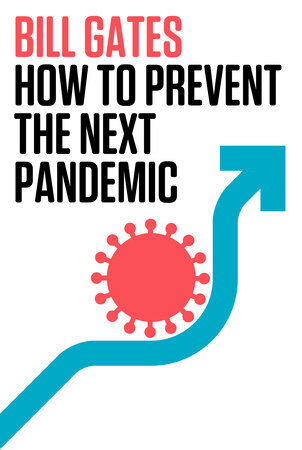How to Prevent the Next Pandemic
If only I led a government or a nongovernmental organization, then maybe I would be cheering with the same unabashed optimism that Bill Gates reveals in his passionate book about the world’s preparedness—or lack thereof—to prevent the next pandemic. As a private citizen, I am left worried about the world’s ability to move the needle on thwarting the spread of viruses as they arise, especially given the wave after wave of COVID-19 variants, the introduction of monkeypox into our collective viral lexicon, and the resurgence of polio. In short, there is cause for concern.
Indeed, in his 304-page tome, How to Prevent the Next Pandemic, Gates first details how the response to the COVID-19 outbreak was middling at best and could have been exponentially worse. He states matter-of-factly that despite people raising the alarm for decades about novel diseases that could kill millions, the world didn’t respond with sufficient urgency. There wasn’t enough investment in the tools needed to prepare for a pandemic properly, i.e., nations were caught flat-footed, militaries weren’t running large-scale drills, and city, state, and federal governments had no practice outside of natural disasters to combat the spread of a deadly virus like COVID-19.
According to Gates, what could help governments, NGOs, the private sector, and philanthropy work together to prepare for the next pandemic is the formation of a “supergroup” of experts who would watch for the next outbreak and spring into action at the first signs. Not only would they raise the alarm, but they would work to contain it, create a data system to share case numbers and other information, standardize policy recommendations and training, assess the ability of individual countries’ national public health institutes to roll out such measures and tools quickly, organize drills, and coordinate with other professionals and systems worldwide.
According to Gates, what could help governments, NGOs, the private sector, and philanthropy work together to prepare for the next pandemic is the formation of a “supergroup” of experts who would watch for the next outbreak and spring into action....
This is a tall order, especially for governments that would have to contend with the politics surrounding the establishment, promotion, and nationwide acceptance of an entity that is not World Health Organization (WHO) or akin to the Centers for Disease Control (CDC) that could have similar involvement, decision-making ability, and authority within the public health system. Like in the United States, that would ostensibly require bipartisan or broad-based buy-in and public engagement. As has become clear, WHO and the CDC were extremely unprepared for COVID-19’s toll. The Atlanta-based CDC has a $12 billion budget and more than 11,000 employees. Still, CDC director Dr. Rochelle Walensky recently admitted the agency fell short in handling COVID-19 and said the agency must move faster and communicate better.
Gates’s plan for his proposed organization, which he has named GERM, for Global Epidemic Response and Mobilization team, is for it to be “well-funded with full-time experts in all the necessary areas, and the credibility and authority that comes with being a public institution.” The team would require 3,000 people plus equipment, travel, and other expenses, costing $1 billion per year to run. Gates indicates that he believes private citizens shouldn’t pay the cost, but he argues it’s a bargain.
Gates leaves open the question of who would foot the bill, landing somewhere between government and private-sector funding. However, his plans do not include bolstering the existing CDC with new funding and resources. Even given the CDC’s mismanagement of the coronavirus pandemic, it’s hard to say whether the U.S. is ready for a new agency. Even in a less highly politicized climate than today’s, efforts to supplant one with the other would probably encounter resistance from the U.S. and possibly other international governments. Gates doesn’t appear to answer the question in How to Prevent the Next Pandemic.
Instead, Gates goes on to examine governmental systems and states that there should be concentrated investment into health systems that make it possible to detect and report pandemic diseases and treat them. He contends that every community in every country should be able to detect an outbreak within seven days, report it, begin an investigation shortly after that, and implement effective control measures. This sounds good—until we consider the U.S. healthcare system’s problems, for example, poor patient outcomes, lack of transparency, high costs of care, lack of insurance coverage for all, nursing and physician shortages, disparities in health outcomes, and other inefficiencies.
Nonetheless, Gates says governments and funders should back innovative ways to increase testing and invest in computer modeling, among other needs for tracking and mitigating a new pandemic. An argument can be made that while investing in mitigating future pandemics is something that surely needs more exploration, so is finding ways to invest in and address problems in existing healthcare systems to better drive innovation.
That’s not to say that Gates’s concern about the next pandemic is misplaced: We are woefully unprepared. Some factions exist that hamper progress in finding viable ways to answer lingering questions about the genesis and proliferation of highly contractable illnesses. Gates is spot-on when discussing the harmfulness of misinformation, how dangerous it can be, and how fast it can travel with tragic consequences to many who believe it. Despite the Herculean feat of developing a COVID-19 vaccine within a year, good science was often rejected, which rendered vaccines and subsequent therapeutics controversial. In their place, efficacy-challenged remedies were touted by high-profile politicians, political pundits, and celebrities. However, Gates is careful about placing blame, instead opting for a course correction for future pandemics through learning from past mistakes.
Gates provides readers with a primer on how therapeutics get approved and shares his expertise with the Bill & Melinda Gates Foundation in producing generic medications and the success of projects like GAVI, the Vaccine Alliance, an organization that pools donations to help developing countries buy vaccines. However, he touches briefly on how the Global COVAX Facility—a mechanism for pooled procurement and equitable distribution of COVID-19 vaccines led by GAVI, WHO, and the Coalition for Epidemic Preparedness Innovations (CEPI), in partnership with UNICEF—fell short of its mark when rich countries pre-ordered billions of doses by negotiating their own deals and proliferated the exact type of vaccine hoarding it was designed to prevent.
Like many scientists at the forefront of monitoring pandemics, Gates believes that broad-spectrum therapies—antibodies or drugs that can treat a wide range of viral infections—are worth more attention and study. He argues again that the world needs to invest in research and systems that will be needed to find treatments faster and deliver them to those in need, wherever they are. The question of “How is that accomplished?” casts a looming shadow over Gates’s optimism throughout much of the book, which includes his vision of governments worldwide ramping up vaccine production and finding the significant funding to make it a reality.
As an author, Gates excels at breaking down scientifically nuanced procedures for the reader. He is adept at sharing through his own experiences and research what he’s learned about vaccines and global health with an excellent understanding of the needs of nations large and small requiring protection from viruses and other life-threatening diseases. A visionary who believes in pursuing high-risk, high-reward opportunities to advance public and global health, he looks to the future of vaccines, where the gaps are bridged, and we can inhale or swallow a vaccine that prevents severe infection or death that provides immunity, doing the tandem duty of protecting oneself and others.
Gates’s interest in the technology behind stopping pandemics is palpable—and would be more encouraging if there weren’t so many telling bureaucratic obstacles in the way and an over-reliance on the private sector stepping in with the expectation of “big profit” as a reward for a role with very little transparency.
Gates’s interest in the technology behind stopping pandemics is palpable—and would be more encouraging if there weren’t so many telling bureaucratic obstacles in the way and an over-reliance on the private sector stepping in with the expectation of “big profit” as a reward for a role with very little transparency.
To his credit, Gates understands the societal roadblocks that have limited science’s ability to protect people, whether due to skepticism of the government, societal barriers like an inability to take time off work to get vaccinated, requiring child care to do so, needing to travel a long distance to a vaccination site, or a failure to ensure access to free vaccines for all who want them. He prioritizes funding and research in his very ambitious agenda to fast-track the manufacturing of vaccines, strengthen supply chains, find better methods to coordinate across governments, improve distribution, and keep the pressure on world leaders. Gates believes disease outbreaks should have just as high a visibility and be taken as seriously as earthquakes and tsunamis for public health and national security reasons.
Should governments, NGOs, the private sector, and philanthropy take Gates’s advice and use this book as a road map to new ideas about stopping or at least slowing the next pandemic? I believe How to Prevent the Next Pandemic is a good conversation starter about what we could be doing in a perfect world and what resources, funding, and other support would be essential to make some of these ideas tangible goals that could become actionable at some point—if the money is procured, governments align and agree on strategy, and society becomes open and accepting to what science has to offer and retains or regains trust in our institutions to make plans like these viable.
Perhaps the larger piece that Gates is missing is that the healthcare systems in the U.S. and beyond are rife with inequities, which in turn prevent those goals from being achieved. The economy is also heavily tilted toward the wealthy, and these inequities, which have existed long before we sounded the alarm about pandemic mitigation, cannot be easily pushed aside. These considerations at their roots impede whatever technological progress we try to attain, and they should be addressed head-on. Gates and we can’t lose sight of how these issues play into the work needed to mitigate pandemics successfully. Still, Gates makes his point about not forgetting the impact of COVID-19, the many lives lost to it, and the reality that it could happen again.
Lauren Brathwaite is content editor at Philanthropy News Digest.







